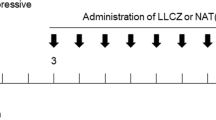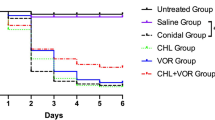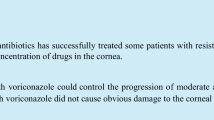Abstract
Purpose
To evaluate the efficacy of topical voriconazole in an experimental rabbit model of Fusarium keratitis.
Methods
Fungal keratitis was induced in the right eyes of 24 New Zealand rabbits. 8.6 × 103 CFU/0.1 ml F.solani spore suspension was injected midstromally into the central cornea. Group 1 received topical amphotericin B 0.15%, group 2 received topical itraconazole 1% and group 3 received topical voriconazole 1% hourly between 08:00 to 22:00 on days 1 and 2; 4 times daily on days 3–5. Control group received topical balanced salt solution at identical intervals. The eyes were examined clinically with a scoring system before treatment (day 0), on day 3 and on day 5. Cultures were taken from the lesion by scraping at the end of the treatment. Clinical scores and microbiologic results were analyzed statistically.
Results
In the control group, keratitis progressed clinically and colony level was 2 × 103 CFU at day 5. In all treatment groups, progression of keratitis was inhibited clinically. Culture was sterile in the group receiving amphotericin B. Colony level was 0.3 × 102 CFU in the itraconazole group and 2 × 102 CFU in the voriconazole group at day 5.
Conclusion
Progression of keratitis was inhibited clinically in all treatment groups. Colony level decreased significantly in all treatment groups. As a result, itraconazole 1% and voriconazole 1% were found to be effective in Fusarium keratitis clinically and microbiologically, although their activity was not as effective as amphotericin B 0.15%.
Similar content being viewed by others
References
Agarwal PK, Roy P, Das A, Banerjee A, Maity PK, Banerjee AR (2001) Efficacy of topical and systemic itraconazole as a broad-spectrum antifungal agent in mycotic corneal ulcer. A preliminary study. Indian J Ophthalmol 49:173–176
Bunya VY, Hammersmith KM, Rapuano CJ, Ayres BD, Cohen EJ (2007) Topical and oral voriconazole in the treatment of fungal keratitis. Am J Ophthalmol 143:151–153
Clancy CJ, Nguyen MH (1998) In vitro efficacy and fungicidal activity of voriconazole against Aspergillus and Fusarium species. Eur J Clin Microbiol Infect Dis 17:573–575
Diekema DJ, Messer SA, Hollis RJ, Jones RN, Pfaller MA (2003) Activities of caspofungin, itraconazole, posaconazole, ravuconazole, voriconazole, and amphotericin B against 448 recent clinical isolates of filamentous fungi. J Clin Microbiol 41:3623–3626
Doczi I, Gyetvai T, Kredics L, Nagy E (2004) Involvement of Fusarium spp in fungal keratitis. Clin Microbiol Infect 10:773–776
Durand ML, Kim IK, D’Amico DJ, Loewenstein JI, Tobin EH, Kieval SJ, Martin SS, Azar DT, Miller FS, Lujan BJ, Miller JW (2005) Successful treatment of Fusarium endophthalmitis with voriconazole and Aspergillus endophthalmitis with voriconazole plus caspofungin. Am J Ophthalmol 140:552–554
Giaconi JA, Marangon FB, Miller D, Alfonso EC (2006) Voriconazole and fungal keratitis: a report of two treatment failures. J Ocul Pharmacol Ther 22:437–439
Gopinathan U, Garg P, Fernandes M, Sharma S, Athmanathan S, Rao GN (2002) The epidemiological features and laboratory results of fungal keratitis: a 10-year review at a referral eye care center in south India. Cornea 21:555–559
Kalavathy CM, Parmar P, Kaliamurthy J, Philip VR, Ramalingam MD, Jesudasan CA, Thomas PA (2005) Comparison of topical itraconazole 1% with topical natamycin 5% for the treatment of filamentous fungal keratitis. Cornea 24:449–452
Klont RR, Eggink CA, Rijs AJMM, Wesseling P, Verweij PE (2005) Successful treatment of Fusarium keratitis with cornea transplantation and topical and systemic voriconazole. Clin Infect Dis 40:110–112
Leck AK, Thomas PA, Hagan M, Kaliamurthy J, Ackuaku E, John M, Newman MJ, Codjoe FS, Opintan JA, Kalavathy CM, Essuman V, Jesudasan CA, Johnson GJ (2002) Aetiology of suppurative corneal ulcers in Ghana and south India, and epidemiology of fungal keratitis. Br J Ophthalmol 86:1211–1215
Lin HC, Chu PH, Kuo YH, Shen SC (2005) Clinical experience in managing Fusarium solani keratitis. Int J Clin Pract 59:549–554
Marangon FB, Miller D, Giaconi JA, Alfonso EC (2004) In vitro investigation of voriconazole susceptibility for keratitis and endophthalmitis fungal pathogens. Am J Ophthalmol 137:820–825
McLeod S (1999) Fungal Keratitis. In: Yanoff M, Duker JS (eds) Ophthalmology. Mosby, UK, pp 5.10.1–5.10.4
Pleyer U, Grammer J, Pleyer JH, Kosmidis P, Friess D, Schmidt KH, Thiel HJ (1995) Amphotericin B-bioavailability in the cornea. Studies with local administration of liposome incorporated amphotericin B. Ophthalmologe 92:469–475
Polizzi A, Siniscalchi C, Mastromarino A, Sacca SC (2004) Effect of voriconazole on a corneal abscess caused by fusarium. Acta Ophthalmol Scand 82:762–764
Reis A, Sundmacher R, Tintelnot K, Agostini H, Jensen HE, Althaus C (2000) Successful treatment of ocular invasive mould infection (fusariosis) with the new antifungal agent voriconazole. Br J Ophthalmol 84:932–933
Schreiber W, Olbrisch A, Vorwerk CK, König W, Behrens-Baumann W (2003) Combined topical fluconazole and corticosteroid treatment for experimental candida albicans keratomycosis. Invest Ophthalmol Vis Sci 44:2634–2643
Tzatzarakis MN, Tsatsakis AM, Charvalos E, Vakalounakis D (2001) Comparison of in vitro activities of amphotercin, clotrimazole, econazole, miconazole, and nystatin against fusarium oxysporium. J Environ Sci Health 36:331–340
Wingard JR, Leather H (2004) A new era of antifungal therapy. Biol Blood Marrow Transplant 10:73–90
Yilmaz S, Maden A (2005) Severe fungal keratitis treated with subconjunctival fluconazole. Am J Ophthalmol 140:454–458
Acknowledgments
We thank Pfizer Global Research and Development Laboratories for providing voriconazole.
Author information
Authors and Affiliations
Corresponding author
Additional information
Voriconazole was provided in powder form from Pfizer Global Research and Development Laboratories.
Rights and permissions
About this article
Cite this article
Yavas, G.F., Öztürk, F., Küsbeci, T. et al. Antifungal efficacy of voriconazole, itraconazole and amphotericin b in experimental fusarium solani keratitis. Graefes Arch Clin Exp Ophthalmol 246, 275–279 (2008). https://doi.org/10.1007/s00417-007-0687-1
Received:
Revised:
Accepted:
Published:
Issue Date:
DOI: https://doi.org/10.1007/s00417-007-0687-1




